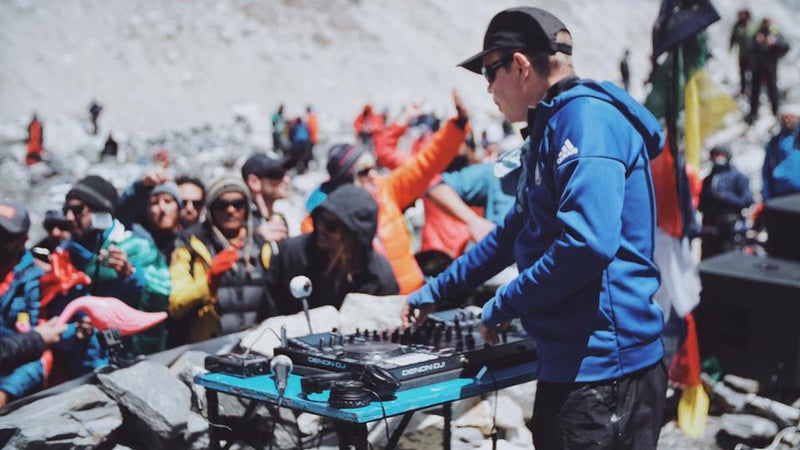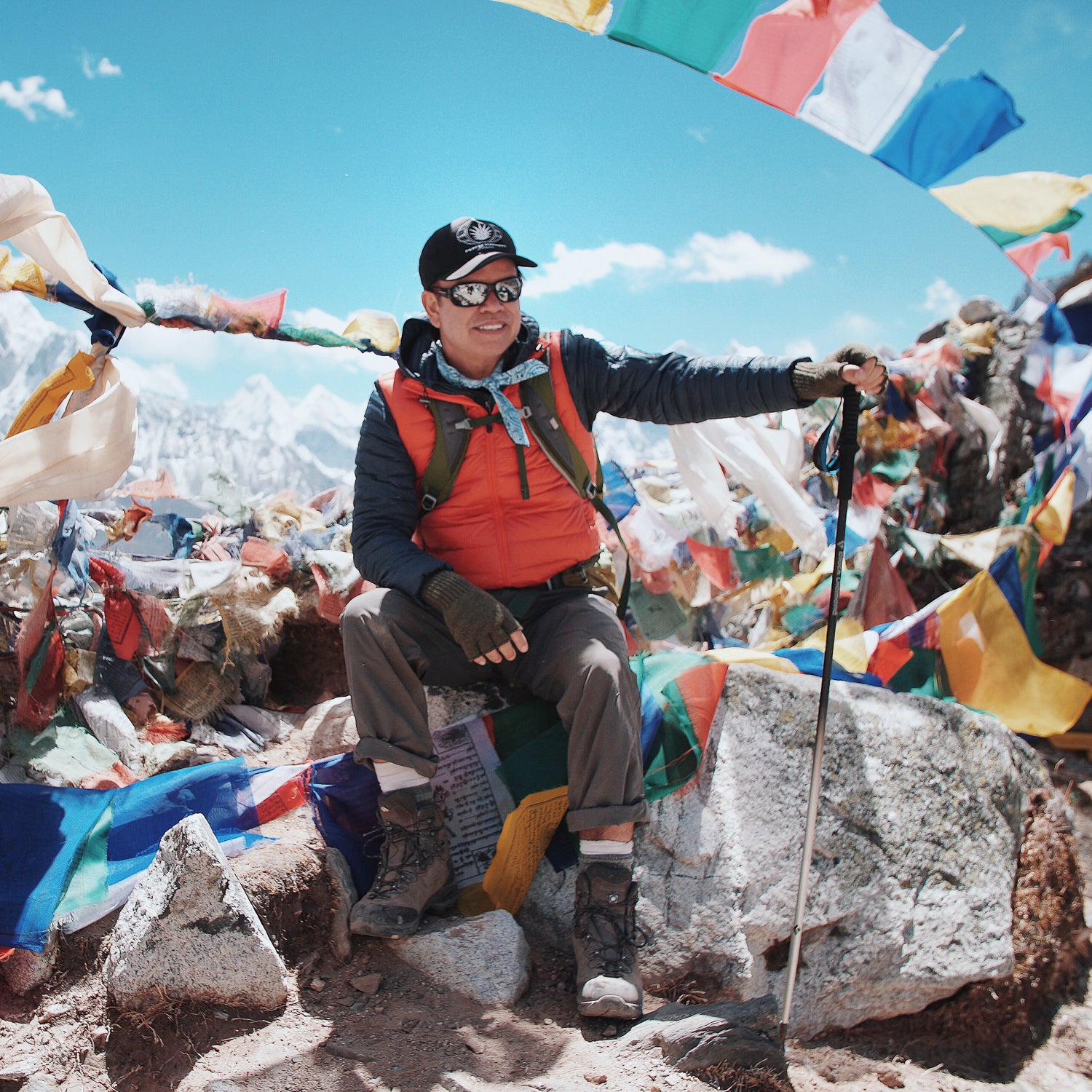Superstar British DJ Paul Oakenfold has spent his entire career throwing epic parties and collaborating with music legends like Madonna and U2. So to mark the 30th anniversary of his first trip to Ibiza, which forever changed dance club culture, the DJ wanted to do something monumental: like throw the highest dance party on the face of the earth.
Yesterday, Oakenfold did just that at Everest Base Camp, which sits at 17,600 feet. The gig, an unexpected stop on his Generations World Tour, is the first in the DJ's , aimed at drawing attention to the effects of global warming and raising money for charities. Oakenfold and plans to release an album and documentary chronicling the trek and performance. “I've played all of the main festivals and all of the main stages and clubs, and don't get me wrong, they are great, but they start to feel all the same,” he says. “Everest opens exciting new doors and that is what inspires me. It allows me to be challenged at this stage of my career and really think about my legacy.”

The three-time Grammy-nominated artist has performed at other headline-grabbing locations, including the Great Wall of China and Ushuaia, the southernmost tip of the world. Everest isn't a publicity stunt, he says. During the ten-day trek to Base Camp, Oakenfold donated coloring books and pencils to village children in Khumjung and challenged them to a soccer match, played impromptu sets at tea houses in Namche and Pheriche, and recorded local music that he plans to mix into a forthcoming album. Proceeds from his tour will go to and and his Denon-brand DJ equipment will be donated to a local DJ school in Kathmandu.
Oakenfold is the first to admit that he’s far from an outdoorsman. In fact, he says he'd never hiked in his life prior to this expedition. It was his friend, nightclub owner Mark Brimblecombe, who approached him about the idea for SoundTrek and performing at Everest. The 53-year-old DJ admits he was excited, but also quite nervous about the challenge. “Something like this has never been done,” he says. “Who even knows if the equipment will work at that altitude. We had to have it shipped, then driven, then put on a helicopter and transported by a team of Sherpas. It might not even arrive in one piece.”
Oakenfold and Brimblecombe approached respected British mountaineer to guide the expedition, which included Oakenfold's tour manager and personal trainer, as well as a photographer and cinematographer and Khatmandu DJ Ranzen Jha. Cool insisted Oakenfold would be fine on the ten-day trek from Lukla to Base Camp, despite his inexperience and the 9,000-foot elevation gain. “Kenton does this type of thing in his sleep,” says Oakenfold. “I hadn't been in a tent since high school and let's just say my lifestyle on tour keeps me up late. I knew I needed to train for this.”
The DJ spent four months training. Phase one consisted of three-mile walks in the hills around his home in Los Angeles. Phase two required him hitting the gym, something he says he hadn't done in decades. He enlisted Mahmood, a trainer at Equinox, to develop a routine focused on core and leg strength exercises like medicine-ball lunges, crunches, and roll-ups. He also took up Pilates. For cardio, he would climb the Stairmaster or walk on the treadmill at a level five incline for one hour. Once that felt comfortable he started wearing an altitude mask. Phase three of his training included hiking outdoors for two to three hours either at home in L.A. or on the road while on tour in mountain towns like Whistler and Salt Lake City. He also spent time in a CVAC Hypobaric Chamber at the Beverly Hills Rejuvenation Center a few times a week for the two months leading up to his expedition. Oakenfold gradually made his way to simulating being at 17,000 feet above sea level in the chamber.
Oakenfold gave up booze and caffeine and committed to a 9:30 p.m. bed time on nights that he didn’t have shows. “My friends can't believe it,” he says. “But I train at 6 a.m. so I can't be out partying until 3 a.m. or I'll really feel it.” To mentally prepare he read books and watched movies about Everest. The group arrived in Kathmandu on March 29, departed Lukla for their trek on March 31, and arrived at Base Camp on April 8 to prep for the show.
Oakenfold mixed tracks from behind a collapsible table and was flanked by streams of prayer flags—a stark contrast to the strobes, lasers, and grand stages he's used to. Unlike most shows, which last until sunrise, the Base Camp performance kicked off at 11 a.m. on April 10. The audience of about 100 puffy coat-wearing Sherpa, guides, and climbers danced along to his trance-like beats, waving selfie-sticks in the air. A bottle of whiskey made its way around the crowd and one reveler even used their hiking boot to chug a beer.
Not everyone was keen about a DJ party at Base Camp. “Unfortunately Everest's reputation as a climber's mountain has suffered over the past decade because people say it's becoming a circus,” says mountain guide Mike Hammill, author of Climbing the Seven Summits. “This performance, I fear, will play perfectly into the stereotype. Some call Everest 'the biggest stage on earth' so it seems appropriate Oakenfold is using this stage, but I think it will be a huge distraction from the serious work going on there and most importantly, the Sherpa may find it sacrilegious as the mountain is a deity.”
Others viewed the exposure as only positive. “Climbing to Base Camp is a non-technical hike, so it doesn't pose a lot of risk,” says climber Adrian Ballinger, of Alpenglow Expeditions. “Throwing legendary parties has always been a part of the Base Camp life.”
Oakenfold plans to play a second show in Kathmandu on April 13, which coincides with Nepal’s new year, then heads to the U.S. to begin the second North American leg of his tour with a show in Cleveland on April 28.


